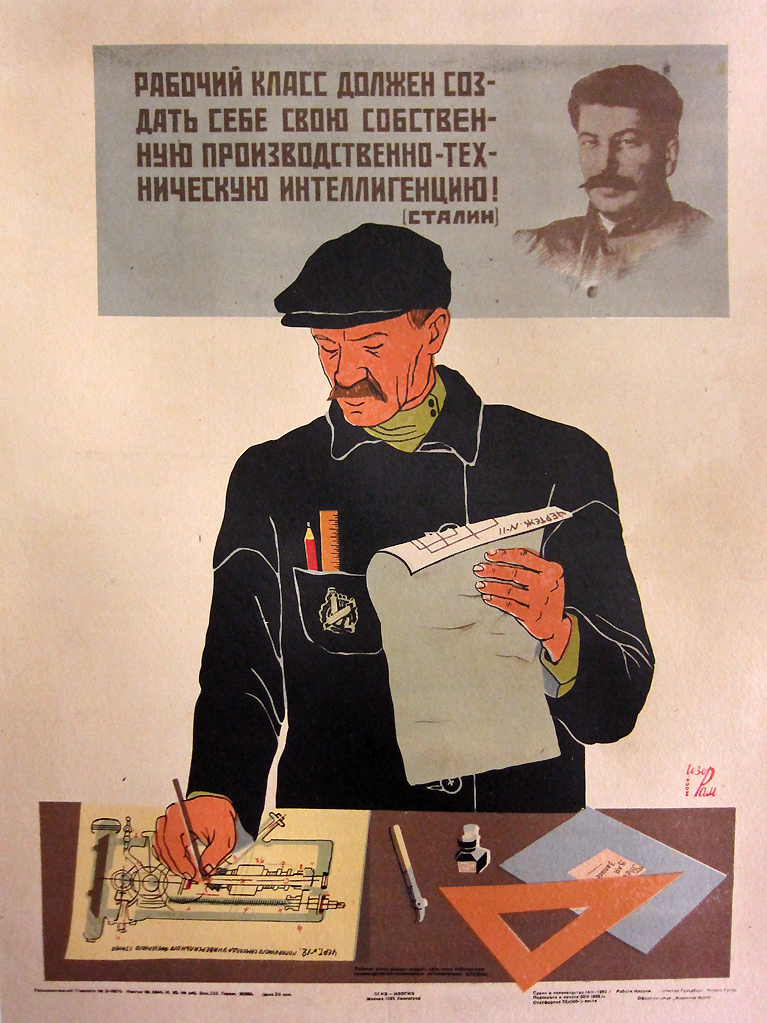
“The working class must create for itself its own technical-production intelligentsia!” – Stalin
Poster Number: PP 865
Category: Workers
Media Size: Please inquire
Poster Type: Offset
Publishing Date: 1932
Editorial Information: Editor Gal’dberg; Technical Editor Gusev; Offset printing by Izvestiia VsTsIK
Technical Information on Poster: Izogiz No. 3344; I 30; Submitted for production February 14, 1932; Approved for printing February 20, 1932; Format 72x100 – 1/2 sheet; No. 840; Order No. 566; Price 40 kopeks
Print Run: 30,050
Glavlit Directory Number: B-15976
Sources & Citation: Arus Auctions, 2016
Catalog Notes: PP 865 Workers b
Artist: Izoram (Fine Arts Studios of Working Youth) — Изомастерские рабочей молодежи (ИЗОРАМ)
Formed in the late 1920s in Leningrad, the Izoram collective attracted amateur artists who worked closely with professionals in a mentoring atmosphere. The collective operated 80 izoiader (art nuclei) overseen by the Visual Arts Department (IZO) of the Commissariat of Enlightenment (Narkompros). Approved in March 1930, Izoram’s declaration boasted: “Izoram is a goal-oriented collective of working youth with a task, under the leadership of the Communist Party and the Komsomol, to actively participate in the clas...
Read More About This Artist
Printer: Izvetsiia (News) All-Union Central Executive Committee Typography Offset Print Shop — Офсет в типографии Известия ЦИК СССР и ВЦИК
Izvestiia (News) All-Union Central Executive Committee Typography Offset Print Shop was located in Moscow and it printed the Izvestiia newspaper. Both Izvestiia and Pravda (Truth) were the leading newspapers in the Soviet Union despite the Soviet-era joke that quipped, "there is no news in Pravda and no truth in Izvestia". Among the longest-running of all Russian newspapers, Izvestiia was founded in Petrograd (St. Petersburg) in March 1917 and was an organ of the Petrograd ...
Read More About This Printer
Publisher: Ogiz-IzoGiz, Moscow-Leningrad — Огиз-Изогиз, Москва-Ленинград
Ogiz was the Association of the State Book and Magazine Publishers. Its main offices were located in Moscow and in Leningrad. The Sovnarkom of the Russian Socialist Federative Soviet Republic established Ogiz in 1930 to centralize publishing activities under a state monopoly in order to eliminate duplication of printed material, streamline and control publishing production and output, and to create a base for marketing books, training and technical manuals. In 1931, the Central Committee of the USSR ...
Read More About This Publisher